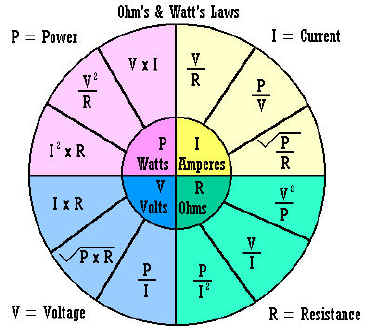Ohm's Law is extremely important in learning basic electronics.
What is Ohm's Law? Ohm's Law is a formula that describes the relationship between resistance, current and voltage in an electrical circuit. The formula is R (resistance in ohms) = (equals) V (voltage in volts) divided by I (current in amperes).
That is: R = V ÷ I
...and algebraic rules tells us that I - V ÷ R and V = I*R.
I = V ÷ R, V = I*R, R = V ÷ I, and P (power in watts) = I*V are the fundamental formulas of Ohm's law. (The * means to multiply the two quantities together). Where V is the circuit voltage in volts, I is the circuits amperage in amps, and R is the resistance in ohms.
Almost every electrical and electronic circuit involves resistance, current and voltage. This is why it is vital you understand the relationships between them.
As an experiment you can set up a circuit by connecting resistors in series with a battery, measure the voltage across the resistors with a voltmeter, measure the current in the circuit by placing an ammeter in series with the resistors and the battery. If you know the voltages and current in the circuit you can use Ohms law to calculate the resistance. With the resistor out of the circuit you can measure it's resistance directly with an ohm meter. The multi-meters today can measure ohms, volts and amperes (usually measured in milliamperes in practical circuits) all in one piece of test equipment.
Below is a graphic chart showing the various relationships between resistance, current, voltage, and power and shows how one unknown can be calculated if you know the other two.


_._
Unequal Resistive Power Divider Calculator - Online

لا تعليقات على : "OHMS LAW"
Post a Comment